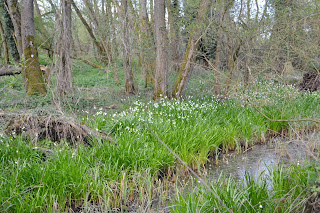30 April 2013 OS
175: Reading & Windsor
Length: half day.
This walk was essentially all about the rare Loddon Lily Leucojum aestivum, which is either native or long-established here along the Loddon and to a lesser extent by the
We started at the car-park of
Comma on its food-plant
Bluebells Hyacinthoides non-scripta were just out - our first of the year; lesser celandine Ficaria verna, garlic mustard Alliaria petiolata, greater stitchwort Stellaria holostea. Many trees and shrubs were flowering: blackthorn Prunus spinosa, Norway maple Acer platanoides, field maple Acer campestris, ash Fraxinus excelsior, wild cherry Prunus avium.
Norway maple flowers &
lichen Xanthoria parietina
Ash flowers
By the streams, lakes and pools (these are former gravel workings) great pond sedge Carex riparia and hemlock water dropwort Oenanthe crocata were common. At the first lake, ducks and geese congregated around the interpretation board where there was obviously regularly feeding. They were largely mallard,
Egyptian goose and mallard
Gadwall quacking
Melanistic mallard?
Freshly-opened
cuckoo-pint Arum maculatum posed for
a picture and could not be refused.
Close-up of Loddon lily
showing orange anthers
We explored the east bank and then crossed the river by the bridge at the south end of the park to follow the west bank north. Where mud had been dredged from the river there were bleached remains of the River Snail Viviparus viviparus, restricted to major rivers like this and the Thames, and Swollen River-mussel Unio tumidus. Deep in the stream could be seen the large submerged leaves of fringed water-lily Nymphoides peltata.
After diverging from the river round a
large field, we followed a path through an equally large marsh. It was fortunate that the path was concreted
here because the water was very high in the centre, coming over our feet, and
it would otherwise have been difficult getting through. It led to a rather decrepit wood (Sandford
Mill Copse?) with some old trees that looked as though it had seen better
times, but by going right at the entrance through fallen wood debris we came across
a swamp with thousands of Loddon lilies crowded around, the largest colony we
found (see picture).
Although neglected and with some rubbish, this copse also contained wood anemone Anemone nemorosa, primrose Primula vulgaris and moschatel Adoxa moschatellina. Some of the latter had distorted stalks and the silvery spore-capsules (sori) of the fungus Puccinia adoxae.
Wood anemone and primrose
Moschatel
Old willows had the common bracket fungi Willow Bracket Phellinus igniarius and Blushing Bracket Daedaleopsis confragosa.
Blushing bracket
At the top of the wood (having found the right route among the meandering paths) we were confronted by the apparent wreck of an aeroplane!
Having found a way
around to the other side we discovered the Berkshire Museum of Aviation. There were a couple of outside exhibits and
much other stuff inside a hanger, but it was currently closed. Just inside the fence by the entrance were
the dead seed-stalks of tower mustard Arabis
turrita, reportedly transferred here when land nearby where it grew was landscaped
for the museum car park. On a barish
grassy bank opposite the entrance grew early forgetmenot Myosotis ramosissima, cornsalad Valerianella
sp, thale cress Arabidopsis thaliana,
common whitlow-grass Erophila varna, parsley-piert
Aphanes arvensis, field woodrush Luzula campestris and leaves of tansy Tanacetum vulgare.
Early forgetmenot
Nearby were garden
yellow archangel Lamiastrum galeobdolon
montanum, garden grape hyacinth Muscari
armeniacum, honesty Lunaria annua,
purple and white forms together, and curly leaves of crow garlic Allium vineale.
Honesty in purple and
white forms
The museum has
access to the lane from Reading
Mosses on bridge, Bryum capillare (green capsules) & Tortula muralis
Shining cranesbill
Just over the
second bridge a path goes left along the east bank of the river again. (Another path across the road re-enters
Dinton Pastures just where there is a large bush of wild plum Prunus domesticus in full flower, with
the leaves unlike blackthorn.)
Wild plum
River Loddon
At Whistley Mill a
heron was fishing beside the wide old mill-pool.
Heron at Whistley Mill
The riverside path
ends here and we had to divert westwards and then north along a wide track
through more lakes reserved for angling clubs and protected by high fences,
spoiling the experience for walkers.
Goldilocks buttercup Ranunculus
auricomus was frequent on the pathside, and occasionally water chickweed Myosoton aquaticum.
Goldilocks buttercup
The path
eventually leads to the road on the west edge of Twyford, where we found a café
for a snack. Alongside the main road,
between the pavement and a cottage wall were a few plants of early scurvy-grass
Cochlearia danica.
Early scurvy-grass in
Twyford
We afterwards
drove to the pleasant old town of Wallingford and walked up the west bank of
the Thames north to opposite Preston Crowmarsh, a place where Loddon lily has
also been recorded, but we only found two well-separated plants and the banks
were too built-up and bare to provide suitable marshy habitat. However, we did find flattened meadow-grass Poa compressa and Mexican fleabane Erigeron karvinskianus growing on Wallingford


























No comments:
Post a Comment